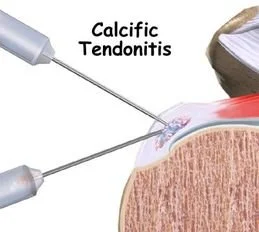Calcific tendinitis
What is calcific tendinitis?
Calcific tendinitis is a common and benign shoulder problem that predominantly affects those older than 30 years of age. Calcific tendinitis refers to small calcium deposits that form in the tendons around the shoulder, the cause for which remains unknown. In many instances these deposits may be present in the shoulder for some time without causing any symptoms, however for reasons that remain uncertain, they can become symptomatic causing pain and ‘impingement’ symptoms in the shoulder. While calcific deposits are not caused by trauma to the shoulder, they may become symptomatic after a traumatic event. In many cases, these calcific deposits can be managed non-surgically, however in some cases surgery may be required if conservative treatment measures do not provide adequate relief of symptoms.
Causes of pain
Calcific deposits cause pain due to either the chemical irritation of the surrounding tissues or, in the case of larger calcium deposits, from mechanical pressure (impingement) of the tendons under the acromion during shoulder movements.
Symptoms
Chronic symptoms: long standing and usually moderate to low pain severity.
Acute/resorptive symptoms: relatively sudden onset of severe pain
A combination of both.
Clinical presentation
Those with ‘chronic’ calcific tendinitis often present with ‘mechanical’ symptoms including shoulder pain and/or clicking with specific movements of the shoulder, usually in elevation of the arm to the side. These symptoms may have been present for months, or even years.
Those suffering an episode of acute, resorptive calcific tendinitis often report the sudden onset of extremely severe pain, including pain at night that prevents sleep. The pain may begin spontaneously, or may follow a traumatic event (minor or major trauma). This pain may last for several days, or 1-2 weeks following which it may completely resolve, or some ‘mechanical’ symptoms may remain.
Investigations
Plain x-ray is the investigation of choice for calcific tendinitis. It will show the presence of most calcific deposits and can be useful for ruling out other significant bony and joint pathology. In some cases an ultrasound scan can also be useful.
Treatment options
1 - Do nothing
Once the initial pain has settled, shoulder function can recover spontaneously over several weeks without the need for any treatment, beyond basic pain relief medications.
2 - Ultrasound-guided injection and fenestration/barbotage procedures
An injection of anaesthetic and corticosteroid (anti-inflammatory) performed under the guidance of ultrasound imaging can provide effective relief for those cases where pain is severe and disabling.
If the calcium deposits are large, causing interference with normal shoulder movement and ‘impingement’ type symptoms, they can also be treated with a procedure called fenestration (needling of the calcific deposits performed using local anaesthetic), or barbotage (injection of saline (salt water), local anaesthetic and corticosteroid (anti-inflammatory) into the calcific deposits). Both of these procedures are done under ultrasound guidance.
3 - Surgery
If the calcium deposits are large and troublesome, surgical excision may be required. Usually, surgery is only recommended if the other procedures (analgesics, anti-inflammatory medications and injection procedures) are unsuitable or have been unsuccessful. The goal of any surgery is to reduce the effects of impingement, by increasing the amount of space between the acromion and the rotator cuff tendons, which will then allow for easier movement and less pain and inflammation.
For more information
Calcific tendinitis: http://tinyurl.com/calcifictendinitis
Ultrasound-guided Barbotage procedure: http://tinyurl.com/calcifictendinitis2

